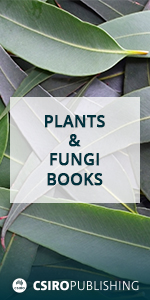
Functional Plant Biology
Volume 42 Number 2 2015
FP14158Shoot branching in response to nodal roots is mimicked by application of exogenous cytokinin in Trifolium repens
Regulation of axillary bud outgrowth in Trifolium repens is dominated by supply of a xylem-transported stimulatory signal from nodal roots. The present study shows this stimulus could be cytokinin-based. It suggests that, in contrast to its much reduced role in erect-stemmed species, xylem-transported cytokinin plays a key role in the outgrowth of axillary buds in prostrate nodally-rooting species.
FP14162Heterotrimeric G-proteins involved in the MeJA regulated ion flux and stomatal closure in Arabidopsis thaliana
Heterotrimeric G-proteins are important elements of the transmembrane signal transmission components. Researchers have indicated that MeJA induced stomatal closure in many species. However, whether heterotrimeric G-proteins involved in the MeJA induced stomatal signal cascade has not yet been evaluated. In this study, heterotrimeric G-proteins were found to regulate the transmembrane H+, Ca2+, K+ flux and then control stomatal closure in Arabidopsis thaliana guard cells response to MeJA. This result provides new insight into the signal cascade of MeJA-induced stomatal closure.
FP14132Ionic and photosynthetic homeostasis in quinoa challenged by salinity and drought – mechanisms of tolerance
Global food production is limited by salinity and drought. Quinoa is a solution, producing seed even at seawater salinities. Unlike other crops, quinoa increased uptake of potassium at high salt concentrations, maintaining photosynthesis and improving water use efficiency. The saturated electrical conductivity resulting in 50% yield was estimated to be 25 dS m–1, higher than any other known crop.
FP14104High night temperature induces contrasting responses for spikelet fertility, spikelet tissue temperature, flowering characteristics and grain quality in rice
High night temperature (HNT) can significantly reduce rice yield and quality. Flowering dynamics, spikelet tissue temperature determines seed-set among diverse rice genotypes exposed to early and/or late night temperature stress. Documented for the first time is a critical night temperature threshold of 27°C beyond which reduction in spikelet fertility is induced. The different sensitivities to HNT of cultivars for spikelet fertility and quality will complement plant breeding efforts targeted towards enhancing resilience of rice cultivars to warmer climates.
FP14135Higher flower and seed number leads to higher yield under water stress conditions imposed during reproduction in chickpea
Ten chickpea genotypes contrasting in yield under terminal stress in the field were exposed to a controlled drought treatment in the glasshouse during reproduction. The ranking for relative seed yield (yield water stress/yield well watered) in the glasshouse conditions differed from the field. High seed yield under drought was linked to higher flower, pod and seed number, especially under mild water stress, while seed size was hardly affected by the drought treatment
FP14083Does age matter under winter photoinhibitory conditions? A case study in stems and leaves of European mistletoe (Viscum album)
European mistletoe (Viscum album) is an evergreen hemiparasitic plant characterised by a continuous photosynthetic surface composed of leaves and stems. We have taken advantage of these traits and used this species as a perfect model plant to study the interactive effect of age and winter on photosynthetic regulation. Winter, as in other temperate evergreens, induces a downregulation of photosynthesis, which in stems is compensated by an ageing-dependent stimulatory effect. Overall, this case study supports the theory of negative senescence.
FP14096Importance of natural cloud regimes to ecophysiology in the alpine species, Caltha leptosepala and Arnica parryi, Snowy Range Mountains, southeast Wyoming, USA
Natural cloud regimes across the globe are expected to change with continued global warming. Yet, little is known about the impacts on plants, except for a few studies showing potentially strong effects on photosynthetic carbon gain and transpirational water loss. We found that these changes to the natural cloud regime had substantial impacts on photosynthesis, transpiration and water use efficiency.
FP14112Water use efficiency in Sangiovese grapes (Vitis vinifera L.) subjected to water stress before veraison: different levels of assessment lead to different conclusions
How grapevines (Vitis vinifera L.) use irrigation under drought needs to be determined. Previous work shows contradictory results regarding the method used. Single-leaf and whole-canopy methods for assessing water use efficiency (WUE) were compared in V. vinifera cv. Sangiovese subjected to progressive water deficit before veraison. Single-leaf WUE assessment was poorly correlated with yield and grape composition, whereas whole-canopy assessment was more reliable. Guidelines were that not less than 70% of daily water use should be supplied to Sangiovese vines before veraison.
FP14142Seed coating reduces respiration losses and affects sugar metabolism during germination and early seedling growth in cereals
We investigated how and why cereal seedlings performed better when grown from hydro-absorber coated seeds. We analysed the proportion of reserves mobilised for growth and respiration and sucrose mobilisation and found that mobilisation efficiency was higher resulting in higher biomass when cereals were coated and in each cereal, sucrose was mobilised differently. Further investigations into oxygen availability while imbibition is occurring have to be done.
FP14081Resilience of a semi-deciduous shrub, Cistus salvifolius, to severe summer drought and heat stress
Climate change is expected to exacerbate summer drought in Mediterranean environments. We analysed the response of a rockrose species to a heat wave superimposed on severe drought, discovering that a combination of physiological and biochemical adjustments allowed survival, with recovery following autumn rains. The shrub’s capacity to withstand substantial seasonal variability may also buffer the impact of significant inter-annual variation in water availability, indicating potential resilience to climate change in the understorey of Mediterranean oak woodlands.




